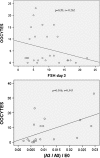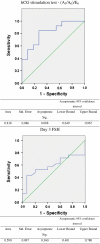The value of human chorionic gonadotropin stimulation test in predicting ovarian response during in-vitro fertilization
- PMID: 21779785
- PMCID: PMC3220435
- DOI: 10.1007/s10815-011-9612-y
The value of human chorionic gonadotropin stimulation test in predicting ovarian response during in-vitro fertilization
Abstract
Purpose: To assess the predictive value of human Chorionic Gonadotropin (hCG) theca-stimulation test for ovarian reserve in women undergoing in-vitro fertilization (IVF) treatments.
Methods: 39 women were included in the study. All participants received a single hCG 10000 IU injection on cycle day 2-3. Serum levels of estradiol, testosterone, androstenedione and 17-OH progesterone were measured prior to the injection and on days 1, 3 and 7 following the injection. hCG-induced hormone levels were compared with ovarian response during the subsequent IVF cycle.
Results: There were 11 good responders (>10 oocytes) and 22 low responders (<3 oocytes). Before hCG stimulation serum E2 levels were higher in low responders compared to good responders (370.3 ± 443 vs. 138.3 ± 54 pmol/ml). Following hCG stimulation, day 3 androstendione levels showed an increase in good responders compared to low responders. The ratio between day 3 androstendione and day 0 estradiol was significantly different between the two groups (p = 0.03). ROC analysis of this test revealed area = 0.837 (good prediction), which was much better than day 3 FSH (area = 0.635, poor prediction).
Conclusions: These preliminary results demonstrate the potential use of the hCG theca stimulation test in differentiating between good and poor responders. Larger series are needed for further verification of the test in routine clinical application.
Figures




Similar articles
-
The effects of low-dose human chorionic gonadotropin combined with human menopausal gonadotropin protocol on women with hypogonadotropic hypogonadism undergoing ovarian stimulation for in vitro fertilization.Clin Endocrinol (Oxf). 2018 Jan;88(1):77-87. doi: 10.1111/cen.13481. Epub 2017 Oct 16. Clin Endocrinol (Oxf). 2018. PMID: 28960429
-
Human chorionic gonadotrophin stimulation test as a predictor of ovarian response and pregnancy in IVF cycles stimulated with GnRH agonist gonadotrophin treatment: a pilot study.Hum Reprod. 2012 Apr;27(4):1122-9. doi: 10.1093/humrep/des008. Epub 2012 Feb 7. Hum Reprod. 2012. PMID: 22313871
-
[Correlation between serum inhibin B level after treatment with gonadotropin releasing hormone agonist and outcome of in vitro fertilization-embryo transfer].Zhonghua Fu Chan Ke Za Zhi. 2009 Apr;44(4):260-2. Zhonghua Fu Chan Ke Za Zhi. 2009. PMID: 19570462 Chinese.
-
Basal serum progesterone and history of elevated progesterone on the day of hCG administration are significant predictors of late follicular progesterone elevation in GnRH antagonist IVF cycles.Hum Reprod. 2016 Aug;31(8):1859-65. doi: 10.1093/humrep/dew141. Epub 2016 Jun 14. Hum Reprod. 2016. PMID: 27301360
-
Assessment of theca cell function prior to controlled ovarian stimulation: the predictive value of serum basal/stimulated steroid levels.Hum Reprod. 2010 Jan;25(1):228-34. doi: 10.1093/humrep/dep378. Epub 2009 Nov 6. Hum Reprod. 2010. PMID: 19897528 Review.
References
-
- Scott RT, Toner JP, Muasher SJ, Oehninger S, Robinson S, Rosenwaks Z. Follicle-stimulating hormone levels on cycle day 3 are predictive of in vitro fertilization outcome. Fertil Steril. 1989;51:651–654. - PubMed
-
- Toner JP, Philput CB, Jones GS, Muasher SJ. Basal follicle-stimulating hormone level is a better predictor of in vitro fertilization performance than age. Fertil Steril. 1991;55:784–791. - PubMed
-
- Rooij IA, Broekmans FJ, Velde ER, Fauser BC, Bancsi LF, Jong FH, et al. Serum anti-Mullerian hormone levels: a novel measure of ovarian reserve. Hum Reprod. 2002;17:101–107. - PubMed
-
- Nardo LG, Gelbaya TA, Wilkinson H, Roberts SA, Yates A, Pemberton P, et al. Circulating basal anti-Müllerian hormone levels as predictor of ovarian response in women undergoing ovarian stimulation for in vitro fertilization. Fertil Steril. 2009;92:1586–1593. doi: 10.1016/j.fertnstert.2008.08.127. - DOI - PubMed
Publication types
MeSH terms
Substances
LinkOut - more resources
Full Text Sources
Other Literature Sources

